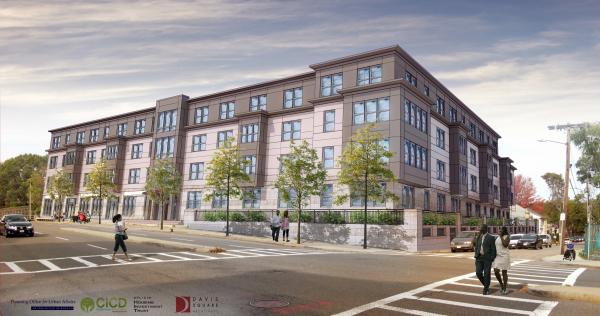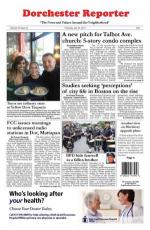August 31, 2017

An updated rendering of the Cote Village project along Cummins Highway in Mattapan, which was greenlit for state funding this month. Image courtesy Davis Square Architects
The fall civic association schedule will be kicking off again next month and a flurry of proposed building projects tops the agendas. The Reporter checked in with planning chairs and heads of groups around Dorchester and Mattapan to ask what patterns they are seeing and what projects are on the horizon.
The Columbia-Savin Hill Civic Association is monitoring major parcels, including the 16.5-acre Boston Globe property on Morrissey Boulevard, which is once again under agreement to be sold, this time to the Nordblom Company. UMass Boston is soliciting ideas from developers for the site of the former Bayside Exposition Center through October.
Next month, the city will begin public meetings on a planning study for Glover’s Corner, a swath along Dorchester Avenue that includes the Dot Block property —working toward demolition on the site — and several other parcels acquired by Hong Kong billionaire Gerald Chan.
Chan has not publically discussed any plans for the Spire Printing site or the Russell Engineering building, which his companies now control. Another major project under way is the South Bay Town Center project, which is targeting an end-of-year grand opening.
“I like it, I think it exciting,” said Eileen Fenton, chair of the Columbia-Savin Hill group’s planning committee. “It’s a wonderful opportunity in our neck of the woods to get development going and a testament to our neighborhood. The downside is the pricing. With good neighborhoods comes high real estate costs.”
The Jones Hill and Hancock Street civic groups are watching projects around the Savin Hill area as well, particularly a controversial plan for 17 units on Pleasant Street at the site of the Scalley & Trayers funeral home. A proposal for a five-story, mixed-used building to replace an auto body shop at 233 Hancock St. is also on their radar, said Bridget Curd, president of the Jones Hill group.
Although an $18 million library planned for Uphams Corner is encouraging, Curd is concerned that the Walsh administration has waved in a very permissive approach to residential development, giving developers “carte blanche.”
“I feel sort of like the neighborhoods are being sacrificed,” she said. “Neighbors that have lived and worked here to make it a neighborhood for all — we’re sort of getting pushed aside.”
Marti Glynn, president of the Hancock Street Civic Association, noted redevelopment of the Chapman Waterproofing Company by the Conservatory Lab Charter School as an upcoming issue. Around Uphams Corner, Curd and Glynn said they were also watching any potential development of the Citizens Bank building on Columbia Road and adjacent properties that the Dudley Street Neighborhood Initiative purchased in April.
Developer James Baker has active projects on two ends of the neighborhood. He received Boston Planning and Development Agency approval this month for two buildings proposed for a prominent corner at Savin Hill Avenue and Sydney Street. The neighborhood largely supported his pitch to bring a local market to the site, with two floors of retail above, as well as a nine-unit condominium building and associated parking next door.
Baker is also pushing for a larger project to replace a Talbot Avenue church with a five-story condominium building, including space for the existing worshippers and a retail tenant.
Doug Hurley, president of the St. Mark’s Area Civic Association, said his group is seeing an increased pace of development, but is trying to balance market pressures with neighborhood cohesion.
“Our membership is very open minded,” Hurley said of the 500 Talbot Ave. project. “We will listen to a developer and give them a chance before making up our minds and saying this is never going to happen.”
Other projects in his civic area are attracting attention, Hurley noted. “We’re seeing the gamut,” he said, from large developments to multi-family conversions.
The 1857-1859 Dorchester Ave. project proposed by Connelly Construction will likely be revisited, Hurley said. At the site of the construction company’s current offices, they have proposed a new 28,555 sq. ft. building, rising five stories and including 20 apartments. It would also house two commercial units on the ground level.
Development has picked up over the last few years, Hurley said. “I think we’re seeing a lot of more of the same things kind of coming at us,” he said. “We’re kind of sandwiched a little bit between three Red Line stations -- Fields Corner, Shawmut, Ashmont. A lot of developers are trying to look at this to get around parking issues throughout the city.”
A proposal of a different kind may stretch along the Red Line tunnel cap from Park Street, where trains from Fields Corner slip into the tunnel, and Shawmut and Ashmont stations. Business owner Travis Lee is working on a project to potentially transform the tunnel cap into a biking and pedestrian greenway.
The Treadmark property at Ashmont, now facing essentially a total rebuilding, brushes up against the territory for the Codman Square Neighborhood Council. Board president Cynthia Loesch said her group is working to better establish a set of standards for developments, which are “happening in such a piecemeal form that we don’t get to look at the neighborhood holistically.”
Plans for a long-controversial city-owned parking lot at the corner of Euclid and Washington streets are still on hold, she noted, as the conversation continues about whether to preserve the parking needs in some way or prioritize building new housing.
“We have serious congestion issues,” she said. “We’d love to be in a space where we’re a more walkable neighborhood, and we’re getting there, but we’re not fully there yet.”
Loesch said the neighborhood council is working to ensure that new construction meets an array of needs in the area, coordinating with outside civic groups who may not have their planning expertise.
“We need to find a way to keep our neighborhood our neighborhood because it’s changing so fast,” she said. “Whatever structures we build, we need to make sure they’re healthy.” So there is overlap between smoke free housing, affordable housing, and green building.
Neponset and Port Norfolk residents are focused on a proposed Neponset Wharf project that would drop 150 units, a 25-room boutique hotel, 85 structured parking spaces, a 4,000-square-foot restaurant/café, and renovated boat storage and service facilities on the former MarineMax/Russo Marine site. The property also includes four acres of watersheet for marina use.
“The Neponset Wharf project is obviously the most significant proposal pending for Port Norfolk, but it also should be closely-watched as an example of planning for the entire Dorchester waterfront,” John Lyons, president of the Port Norfolk Civic Association, wrote in an email.
He said the development team “seems to be seeking support from everywhere other than the neighborhood, with a particular emphasis on social media. There has been no discussion of modification of the plan, which is generally perceived as much too large for this isolated peninsula.”
Lower Mills civic members continue to monitor a proposal for the former Molloy funeral parlor on Washington Street. Developers filed with the city this week, pitching 57 condominiums and street-fronting retail space.
Mattapan is seeing some major development underway, as well.
The Preservation of Affordable Housing and the Nuestra Comunidad Development Corporation filed plans in August for a sprawling $57 million mixed-use project in Mattapan Square. A residential, commercial, and retail project is planned for an underutilized 2.57-acre MBTA parking lot by the Mattapan terminus of the high-speed trolley, including 135 units of mixed-income rental apartment housing, commercial/retail space, community space, and nine homeownership units.
Earlier this month, Gov. Charlie Baker announced a new round of funding that will kick off the long-awaited Cote Village project along Cummins Highway. The Caribbean Integration Community Development and Planning Office for Urban Affairs, Inc. can move ahead with their housing complex proposal at the old Cote Ford dealership after receiving $4,750,000 in soft loans, about $1.55 million in housing tax credits, and $5.56 million in city funding.
“For our part, to be able to take that property that’s been vacant for 20 years… I think that’s going to be be very transformative for the neighborhood,” said Lisa Alberghini, president with the planning office.
News editor Jennifer Smith can be reached at jennifer.smith@dotnews.com or follow her on Twitter at @JennDotSmith
Topics:



